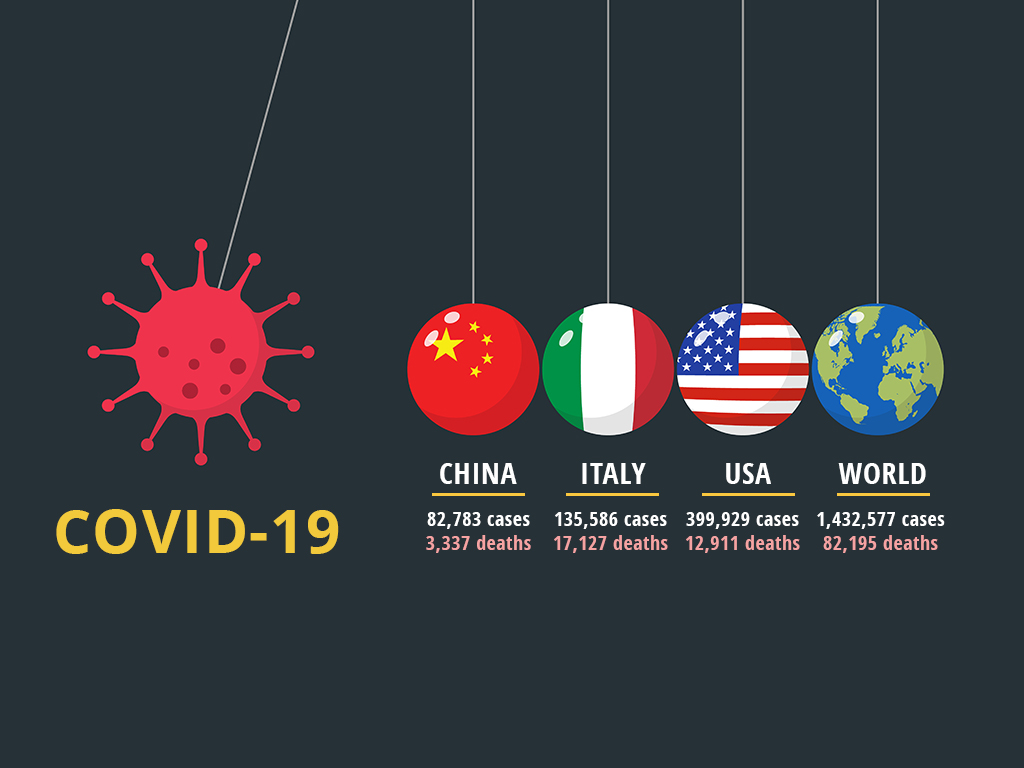100 days of COVID-19
The pandemic
100 days after the first case was reported to the World Health Organisation from Wuhan, China, COVID-19 has spread across the globe at an immense rate.
Three and a half months on, there are more than 1.4 million confirmed cases of COVID-19, with more than 300,000 recoveries in 184 countries.
Of those confirmed cases, deaths are a little over than 82,000, a fatality rate of about 6 per cent.
Life has turned upside down in the past 100 days since the onset of the pandemic.
Global lockdowns have made the once-bustling roads, busy airports, crowded parks, and other public places silent and empty.
Key dates of COVID-19
December 31, 2019
The WHO is informed of an outbreak of a mystery respiratory illness in the central Chinese city of Wuhan. 27 people had viral pneumonia – seven of whom are in a serious condition in hospital.
January 3, 2020
The number of confirmed cases increases to 44, most of which have been traced to the South China Seafood City food market in Wuhan, where products are reported to include wild animals that carry viruses dangerous to humans.
January 8, 2020
The World Health Organization (WHO) says a NEW CORONAVIRUS could be behind a pneumonia epidemic documented in Wuhan.
January 11, 2020
China announces its first death in Wuhan, that of a 61-year-old man with “severe underlying health issues”.
January 20, 2020
First signs of the virus spreading emerge. New cases are reported in Beijing and Shenzhen, as the death toll rises to three. Officials in Thailand and Japan confirm at least three cases, all involving recent travel from China.
January 22, 2020
Wuhan goes into travel lockdown, with outbound flights and trains stopped, and bus routes closed in a bid to curb the virus’s spread. The death toll stands at 17.
January 24, 2020
Wuhan is quarantined. Transport links shut down in at least 13 cities which are home to more than 36 million people. Also, the first case in Europe is recorded.
January 25, 2020
Chinese New Year is a subdued affair, with more than 1,200 cases of coronavirus and more than 40 deaths. President Xi Jinping describes it as a grave situation.
January 28, 2020
Germany and Japan announced the first two confirmed instances of human-to-human transmission of COVID-19 outside China. Many nations rushed to evacuate their citizens from China.
WHO declares coronavirus as “Public Health Emergency of International Concern”
January 30, 2020
The WHO declares a “public health emergency of international concern”. China reports more than 7,800 cases including 170 deaths.
February 2, 2020
The Philippines reports the first death outside China, a man from Wuhan.
February 3, 2020
Scientists identify bats are the potential source of coronavirus.
February 7, 2020
Dr Li Wenliang, the doctor who was targeted by police for trying to sound the alarm on a “SARS-like” virus in December, dies of the coronavirus.
“COVID-19 becomes official”
February 11, 2020
The World Health Organization says the official name for the disease caused by the new coronavirus is COVID-19.
February 14, 2020
A Chinese tourist who tested positive for the virus dies in France, becoming the first person to die in the outbreak in Europe. Egypt announced its first case of COVID-19
February 19, 2020
The toll tops 2,000, the WHO calls for “proportionate” actions to COVID-19’s international spread. Meanwhile, passengers disembarked the Diamond Princess cruise ship after being quarantined in Yokohama.
February 25, 2020
The WHO says there is a risk of a pandemic. The next day the number of new cases in the rest of the world surpasses that of China.
COVID-19 in the Caribbean Shores
March 1, 2020
COVID-19 reaches the Caribbean. Health authorities confirm cases from the Dominican Republic, St. Barthélemy (St. Barts) and French Saint Martin.
March 6, 2020
More than 100,000 cases have been recorded around the world.
March 8, 2020
Northern Italy is locked down, quickly followed by the rest of the country.
March 11, 2020
The WHO says COVID-19 is a pandemic. US borders gradually close to around 30 countries.
March 13, 2020
The WHO says Europe is the pandemic’s new epicentre. Many countries started to shut their borders.
March 18, 2020
More than 200,000 cases have been registered.
March 19, 2020
Italy becomes the country with the highest death toll. Hundreds of countries and territories announce confinement measures.
March 24, 2020
Japan’s 2020 Olympics are postponed.
March 25, 2020
Clarence House confirmed that Prince Charles, heir to the British throne has tested positive for COVID-19.
March 28, 2020
China’s Wuhan starts to emerge from lockdown while Italy passes the 10,000-death mark.
April 2, 2020
The Johns Hopkins University count of people confirmed to have Covid-19 passes 1 million, with more than 50,000 people dead.
April 5, 2020
Queen Elizabeth II addresses the nation in a rare television broadcast.
April 8, 2020
The United States is about to breach 400,000-mark of confirmed COVID-19 infections, the highest caseload in the world.
What’s next?
Covid-19, like climate change, is now partly part of the economy.
And while there is no doubt that one day the pandemic will end., what no one can say is just what state of the economy and society will be in when the day finally comes.



